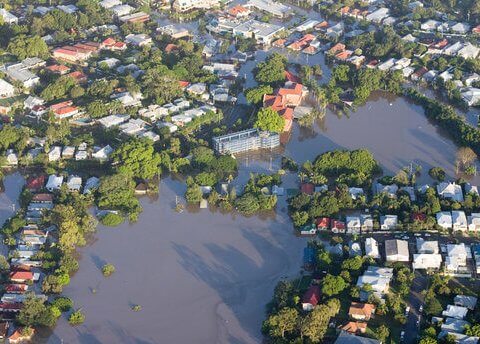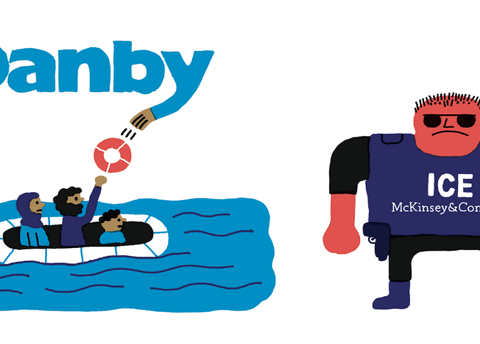In 2017, 12 of the mere 450 North Atlantic right whales left on Earth became entangled in fishing gear in the Gulf of St. Lawrence in Canada’s maritime provinces. Five died. Three managed to escape. People freed another three, and one disappeared. Another five were killed by ship strikes. Pressure mounted on the fishing industry and regulators to do something.
Whales are particularly vulnerable to “fixed gear” fishing, in which traps set on the seafloor to catch crabs and lobsters are connected via ropes to buoys on the surface. In areas where fishing is dense, these hanging ropes create an obstacle course for whales and other animals, including leatherback and loggerhead turtles. Canadian waters also saw 80 humpback and 40 minke whale deaths last year, with entanglement as one of the main causes. Entanglement in fishing gear was the No. 1 cause of death for all large whales. On right whales’ migratory routes, calving and foraging areas along the East Coast of North America, from Georgia to the Gulf of St. Lawrence, the whales must swim a gauntlet of an estimated one million vertical fishing ropes attached to crab and lobster traps.
The high death toll in 2017 was in part due to the right whales moving into new territory, where protections for them didn’t exist. In response to these deaths, the Department of Fisheries and Oceans Canada (DFO) put out an action plan in March of this year. Recommendations include slowing boats when whales are present, closing part of the gulf to snow crab fishing, looking for whales with airplane surveillance and underwater microphones, limiting the amount of rope that fishers can use, requiring fishers to report interactions with marine mammals, and testing new fishing technologies.
Some methods outlined by the DFO have been tried on the U.S. East Coast for years, said Tim Werner, senior scientist and director of the Consortium for Wildlife Bycatch Reduction at the New England Aquarium in Boston, yet whale entanglement deaths have nevertheless been steadily increasing since 2000.
Now researchers and fishers in Canada and on the U.S. East Coast are testing “ropeless” fishing gear that has the potential to reduce bycatch and make it possible for fishers to avoid closures. One type of system holds the rope and buoy on the bottom, next to the trap, out of whales’ way. To retrieve the trap, a device releases the buoy and rope to the surface rope, either at a timed interval or by sending an acoustic signal to the device to open. Another system has no rope at all but rather a bag attached to the trap that can inflate and lift it – if the contents aren’t too heavy.
One company, Desert Star Systems, has been selling the first type of system to fishers in Australia since 2013. On a cool coastal summer day, I drive through sand dunes just north of Monterey, California, to Desert Star’s headquarters, a low-slung, no-frills concrete building, next to a small regional airport. I find CEO Marco Flagg on the floor with a fellow engineer, wrapping rope around a plastic colander to test an idea about improving their product.
Flagg, a friendly, open German immigrant, is optimistic that his invention can help to save the whales.
Acoustic release technologies have been available since the 1960s, but early models were expensive and unreliable, he said. Desert Star’s patented technology, called a fusible link, uses a jolt of electricity to melt a wire, releasing a lever that allows the buoy and rope to rise to the surface. To make this work in cold water, the heating must be very fast. “We do this by charging a capacitor first, which can deliver the stored charge very rapidly,” said Flagg. In two-thousandths of a second, the wire reaches 1,400 degrees Celsius and melts. The speed also limits the energy required, he said. “One set of four AA alkaline cells is enough for about 50 release cycles.”
Later we go down to a dock at Monterey Bay so Flagg can demonstrate the device. The trap splashes into the water and sinks. Flagg calls for it, broadcasting codes that identify himself and the equipment through a sonar transducer. The lever releases and the float bobs right up.
Desert Star’s market for this product has been primarily in Australia, where lobster fishers were losing gear to storms and ships cutting their lines and to other fishers poaching their traps.
In North America, acoustic releases haven’t been widely used, primarily due to cost. But with endangered species teetering on the brink, the perceived value of the gear may begin to change.
Other companies with varied technologies, some at early stages of development, include SubSea Sonics in El Cajon, California; Fiomarine in Tasmania, Australia; Sea Mammal Education Learning Technology Society, a nonprofit out of Washington state; and EdgeTech, based in Massachusetts.
EdgeTech, another company that already has commercial products, has a simple system, said Rob Morris, product line sales engineer for the firm. “There’s a high-torque motor that just turns a shaft and unwinds a screw,” he said. “And the screw falls away and the system releases, so there’s no lever or anything that could become entangled with biofouling.” The system has a 99 per cent success rate, Morris said.
SNOW CRABBERS TEST GEAR
Desert Star and EdgeTech ropeless fishing gear are being tested in the Gulf of St. Lawrence by the Acadian Crabbers Association, said the group’s director-general, Robert Haché. Ropeless technology “is not pie in the sky. It’s ready and easily adaptable to our fishery,” he said. Whether it’s affordable is another question.
Because of the price, “Having this system installed on 30,000 to 40,000 traps in the southern Gulf of St. Lawrence at this time is totally unrealistic,” said Haché, adding that he hopes that economies of scale will bring the price down.
Flagg says the Desert Star device costs from US$755 to US$1,995, depending on quantity purchased. Because it has a life expectancy of “well over 10 years,” he estimates an annualized cost, with maintenance, of about $200 per year.
EdgeTech’s new system, developed with lobster fishers in the United States, will cost around US$4,000, Morris said. He also estimates a lifespan of 10 or more years for his device.
The fishers who use Desert Star devices in Australia find that it pays off, said Flagg, The cost of the device is “offset by savings due to reduced poaching, equipment loss to ship strikes, weather, and the like.”
In North America, the devices may allow fishers access to zones otherwise closed, “and thus realize very substantial savings in ship time compared to more distant, alternate grounds,” said Flagg.
Haché said that nearly 30 per cent of the snow crab fishing area was closed last spring, and that using ropeless technology just in those areas would be an advantage.
Werner from the New England Aquarium said he’s been impressed with the quick response and positive attitude from DFO and Canadian fishers toward solving the problem – something he doesn’t see as much at home in New England. That readiness to change could be because the Gulf of St. Lawrence snow crab fishery recently lost its marine stewardship certification due to the whale entanglement issue.
Whatever the motivation, Haché said his group’s primary interest in ropeless traps is “to coexist with the North Atlantic right whale. There’s no future for us unless we can accommodate this cohabitation.”





